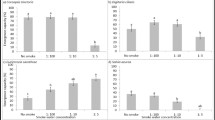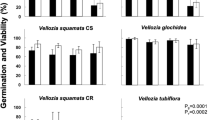Abstract
Nicotiana attenuata is a native tobacco that is commonly found usually one growing season after fires in the blackbrush, sagebrush and pinyon-juniper forests of the Great Basin desert of North America. This plant also occurs in isolated dry washes and roadsides for many consecutive seasons. Postfire annuals are thought to synchronize their germination from the seed bank with the postfire environment in response to increases in (1) fire-related cues or (2) nutrient supply rates resulting from the mineralization of nutrients by fire, or (3) the removal of allelochemicals produced by the dominant vegetation occupying the sites before the burn or the microbial community associated with the dominant vegetation. We examine the effect of these three changes on the germination ofN. attenuata seed from artificial seed banks made with burned and unburned soil taken in 1993 from under four dominant shrub species (Coleogyne ramosissima, Yucca baccata, Lycium andersonnii, Purshia tridentata) of an area that burned in 1992 and from two dry washes in whichN. attenuata populations have persisted since at least 1988. We utilize our recent discovery that aqueous extracts of wood smoke contain potent germination cue(s) for this species and the established observation that nitrate stimulates germination in manyNicotiana species. In two experiments, we added smoke-derived germination cues and nutrients separately and in combinations to the artificial seed banks, measured germination rates, and inferred the effect of burning by the response of the seed banks to these additions. Germination rates of seed in burned soil were consistently higher than those in unburned soil collected from under all species tested; concentrations of nitrate, P, Mn, and Ca were also higher in burned than unburned soils. Because the addition of more cue and nitrate to burned soil increased germination rates, these soil components may not be at concentrations sufficient to saturate the germination response one year after a fire. The germination of seeds in soil collected from beneath unburnedYucca bacatta plants increased to the same level as that found under burned plants of the same species with the addition of cue and nitrate. Similarly, unburned bitterbrush soil attained the same germination potential with the addition of cue and a complete nutrient solution as burned bitterbrush soil. We conclude that the effect of fire on the germination potential of bitterbrush and yucca soil is due to increases in germination cue and nutrients. However, since the addition of cue and nutrients to the unburned soils under blackbrush and wolfberry shrubs did not elevate the germination potential of these soils to that found in burned soils, we conclude that these species alter the soil so as to inhibit germination and burning reverses this alteration. The presence of persistentN. attenuata populations in washes could not be attributed to particular chemical characteristics of these soils. Additions of cue dramatically increased germination potential of these soils, whereas the addition of nitrate did not. The concentrations of most mineral nutrients resembled those found in the unburned sites with the exception of Mn, Cu, and Zn, which were higher. However, these cations do not influence germination rates. Treatment of soil taken from these washes with cue resulted in significant increases in germination ofN. attenuata seeds in the natural seed bank compared to water-treated controls, demonstrating that the plants growing in washes also produce dormant seeds that require the smoke cue for germination.
Similar content being viewed by others
References
Baldwin, I.T., andOhnmeiss, T.E. 1993. Alkaloidal responses to damage inNicotiana native to north america.J. Chem. Ecol. 19:1143–1153.
Baldwin, I.T., Staszak-Kozinski, L., andDavidson, R. 1994. Up in smoke: I. Smoke-derived germination cues for post-fire annualNicotiana attenuata Torr. Ex. Watson.J. Chem. Ecol. 20:2345–2371.
Barney, M.A., andFrischknecht, N.C. 1974. Vegetation changes following fires in the pinyon-juniper type of west-central Utah.J. Range Manage. 27:91–96.
Bewley, J.D., andBlack, M. 1982. Physiology and Biochemistry of Seeds. Springer-Verlag, Berlin.
Bowns, J.E. 1973. An autecological study of blackbrush (Coleogyne ramosissma Torr) in southwest Utah. PhD. dissertation. Utah State University, Logan, Utah.
Bowns, J.E., andWest, N.E. 1976. Blackbrush (Coleogyne ramosissma Torr) on southwest Utah rangelands.Utah Agric. Exp. Stn. Res. Rep. 27:1–27.
Britton, C.M., andRalphs, M.H. 1978. Use of fire as a management tool in sagebrush ecosystems. The Sagebrush Ecosystem: A Symposium, Utah State University, College of Natural Resources, Logan, Utah.
Brotherson, J.D., Szyska, L.A., andEvenson, W.E. 1980. Poisonous plants of Utah.Great Basin Nat. 40:229–253.
Christensen, N.L., andMuller, C.H. 1975a. Effects of fire on factors controlling plant growth inAdenostoma chaparral.Ecol. Monogr. 45:29–55.
Christensen, N.L., andMuller, C.H. 1975b. Relative importance of factors controlling germination and seedling survival inAdenostoma chaparral.Am. Mid. Nat. 93:71–78.
Christian, R.W. 1962. Plant geography of the Beaver Dam Mountains. MA dissertation. University of Utah, Salt Lake City.
Emery, D.E. 1992. Seed Propagation of Native California Plants. Santa Barbara Botanic Garden, Santa Barbara, California.
Goodspeed, T.H. 1954. The GenusNicotiana. Chronica Botanica Company, Waltham, Massachusetts.
Ho, C., Lee, C.Y. andHuang, M. 1992. Phenolic Compounds in Food and Their Effects on Health. Vols. I and II. American Chemical Society, Washington, D.C.
Karssen, C.M., andHilhorst, H.W.M. 1992. Effect of chemical environment on seed germination, pp. 327–348,in M. Fenner (ed.). The Ecology of Regeneration in Plant Communities. CAB International, Southampton, U.K.
Kaminsky, R. 1981. The microbial origins of the allelopathic potential ofAdenostoma fasciculatum H & A.Ecol. Monogr. 51:365–382.
Kelley, J.E. 1991. Seed germination and life history syndromes in the California chaparral.Bot. Rev. 57:81–116.
Keeley, J.E., andKeeley, S.E. 1989. Allelopathy and the fire-induced herb cycle.Nat. Hist. Mus. Los Angeles Cty. Sci. Ser. 34:65–72.
Keeley, S.C., andPizzorno, M. 1986. Charred wood stimulated germination of two fire-following herbs of the California chaparral and the role of hemicellulose.Am. J. Bot. 73:1389–1397.
Kelley, J.E., Morton, B.A., Pedrosa, A., andTrotter, P. 1985. Role of allelopathy, heat and charred wood in the germination of chaparral herbs and suffrutescents.J. Ecol. 73:445–458.
Koniak, S. 1985. Succession in pinyon-juniper woodlands following wildfire in the great basin.Great Basin Nat. 45:556–566.
Koniak, S., andEverett, R.L. 1982. Seed reserves in soils of successional stages of pinyon woodlands.Am. Mid. Nat. 108:295–303.
Philippi, T. 1993. Bet-hedging germination of desert annuals: Beyond the first year.Am. Nat. 142:474–487.
Wells, P.V. 1959. An ecological investigation of two desert tobaccos.Ecology 40:626–644.
Wendorff, W.L., Riha, W.E., andMuehlenkamp, E. 1993. Growth of molds on cheese treated with heat or liquid smoke.J. Food Protect. 56:963–966.
Went, F.W., Juhren, G., andJuhren, M.C. 1952. Fire and biotic factors affecting germination.Ecology 33:351–364.
Wicklow, D.T. 1977. Germination response inEmmenanthe penduliflora (Hydrophyllaceae).Ecology 58:201–205.
Wright, H.A., andBailey, A.W. 1982. Fire Ecology. John Wiley and Sons, New York.
Wright, H.A., Neuenschwander, L.F., andBritton, C.M. 1979. The Role and Use of Fire in Sagebrush-Grass and Pinyon-Juniper Plant Communities. General Technical Report INT-58, U.S.D.A. Forest Service.
Young, A., andEvans, A. 1978. Population dynamics after wildfires in sagebrush grasslands.J. Range Mange. 31:283–289.
Author information
Authors and Affiliations
Rights and permissions
About this article
Cite this article
Baldwin, I.T., Morse, L. Up in smoke: II. Germination ofNicotiana attenuata in response to smoke-derived cues and nutrients in burned and unburned soils. J Chem Ecol 20, 2373–2391 (1994). https://doi.org/10.1007/BF02033208
Received:
Accepted:
Issue Date:
DOI: https://doi.org/10.1007/BF02033208




